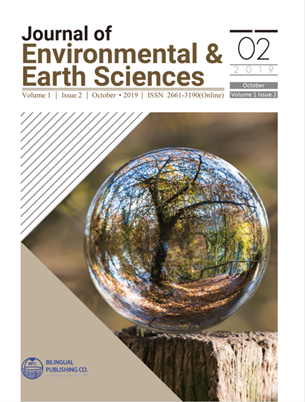
Paleo-environmental Conditions, Paleoclimatic Significance and Effects of Weathering on Clay Deposits in the Lower Benue Trough, Nigeria. Mineralogical Approach
DOI:
https://doi.org/10.30564/jees.v1i2.904Abstract
Combined methods for mineralogical identifications were used to characterise the clay deposits within the Lower Benue Trough of Nigeria to interpret paleo-environmental conditions, the paleoclimatic significance of the trough, and effects of weathering on the minerals as factors that favour its deposition/accumulation within the trough which host other important industrial minerals like coal, barite, limestone etc. Bulk-sample random-powder XRD data and data for clay fractions deposited onto zero-background quartz plates were measured. The samples contained kaolinite, vermiculite, and traces of smectite, and the non-clay phases included quartz, microcline, and muscovite. All samples were unaffected after glycolation, confirming the absence of significant smectite. Muscovite was characterized by the nature of its 10 Å basal peak with a width of <0.10° 2θ, which was very sharp. DTA/TGA results support the presence of kaolinite, and the characteristic kaolinite O-H, Al-OH, Si-OH and SiO-Al FTIR bands also confirmed its presence. Vermicular and book-like morphologies were observed under the SEM, typical of kaolinitic clay from in situ alteration. High kaolinite abundance in these sediments is consistent with intense weathering of parent rocks rich in Al under wet/ tropical paleo-climatic conditions with fresh and/or brackish water conditions in a continental setting. The variety of observed morphologies suggests that the deposits suffered more of chemical weathering. The clay deposits in Lower Benue Trough are quartz-rich, kaolinitic and derived from the chemical weathering of Al-rich source rocks.
Keywords:
Paleo-environmental conditions; Al-rich source rocks; Clay mineralogy; Chemical weathering; Lower Benue TroughReferences
[1] Mpuchane S., G. Ekosse, B. Gashe, I. Morobe, and Coetzee, S.. Mineralogy of Southern African medicinal and cosmetic clays and their effects on the growth of selected test microorganisms. Fresen. Environ. Bull. 2008, 15: 547-557.
[2] Meunier, A. and Velde, B.. Illite. Springer, Berlin, 2004.
[3] Shichi, T and Takagi, K.. Clay minerals as photochemical reaction fields. J. Photochem. Photobiol. C: Photochem Rev., 2000, 1, 113.
[4] Nayak, P. G and Singh, B. K.. Instrumental characterization of clay by XRF, XRD and FTIR. Bull. Mater. Science, 2007, 30: 235-238.
[5] Burhan, D and Ciftci, E.. The clay minerals observed in the building stones of Aksaray - Guzelyurt area (Central Anatolia-Turkey) and their effects. International Journal of the Physical Sciences, 2010, 5: 1734-1743.
[6] Nesbitt, H.W. and Young G.M. Formation and diagenesis of weathering Profiles. J. Geol. 1989, 97: 129–147.
[7] Singh, P.. Major, trace and REE geochemistry of the Ganga River sediments: Influence of provenance and sedimentary processes. Chemical geology, 2009, 266: 242-255.
[8] Frallick, P.N. and Kroneberg, B.J.. Geochemical discrimination of clastic sedimentary rock sources”. Sedimentary Geology, 1997, 113: 111-124.
[9] Nesbitt, H.W., Young, G.M., McLennan, S.M., Keays, R.R.. Effects of chemical weathering and sorting on the petrogenesis of siliclastic sediments, with implications for provenance studies. Journal of Geology, 1996, 104: 525-542.
[10] Cox, R., Low, D.R., and Cullers, R.L.. The influence of sediment recycling and basement composition on evolution of mudrock chemistry in the southwestern United states. Geochimica et Cosmochimica Acta, 1995, 59: 2919-2940.
[11] Petters, S.W. and Ekweozor, C.M, Petroleum geology of Benue Trough and southern Chad Basin Nigeria: AAPG. Bull. 1982, 66: 1141–1149.
[12] Obaje, N.G.. Geology and Mineral Resources of Nigeria. Lecture Notes in Earth Sciences. Springer-verlag, Berlin, Heildeberg. 2009, 120: 57-68.
[13] Bolarinwa, A.T., Idakwo. S.O. and Bish, D.L.. Rare-Earth, Trace Element, and Hydrogen and Oxygen Isotopic Composition of Cretaceous Kaolinitic Sediments from the Lower Benue Trough, Nigeria: Provenance, Depositional and Paleoclimatic Significance. Acta Geochim, 2019. https://doi.org/10.1007/s11631-019-00328-y
[14] Simpson, A.. The Nigerian coalfield. The geology of parts of Onitsha, Owerri and Benue provinces. Bulletin Geological Survey Nigeria, 1954, 24(8): 85.
[15] Reyment, R.A.. Aspects of the geology of Nigeria. Ibadan University Press, Ibadan, Nigeria, 1965: 133.
[16] Bish, D. L. and Howard, S. A.. Quantitative phase analysis using Rietveldt method. J. Appl. Cryst. 1988, 21: 86-91.
[17] Bish, D. L. and Post, J. E.. Quantitative mineralogical analysis using the Rietveld full - pattern fitting method. American Mineralogist, 1993, 78: 932-940.
[18] Moore, D.M. and R.C. Reynolds. X-Ray diffraction and the Identification and Analysis of Clay Minerals, Oxford (Oxford University Press), 1989: 332.
[19] Gharrabi, M., Velde, B. and Sagon, J.P. The transformation of illite to muscovite in pelitic rocks: Constraints from X-ray diffraction. Clays and Clay Minerals, 1998, 46: 79-88.
[20] MacKenzie, R.C. The Differential Thermal Investigation of Clays. Monogrph 3, Mineralogical Society, London, 1957: 456.
[21] Felhi,M., Tlili, A., Gaied, M.E., and Montacer, M.. Mineralogical study of kaolinitic clays from Sidi El Bader in the far North of Tunisia. Applied Clay Science, 2008, 39: 208-217.
[22] Gadsen J.A. Infrared spectra of minerals and related inorganic compounds. Butterworth, London, 1975.
[23] Keller, W.D.. Classification of kaolins exemplified by their texture in Scan Electron Micrographs. Clays and Clay Minerals, 1978, 26: 1-20.
[24] Keller, W.D.. The nascence of clay minerals. Clays and Clay Minerals, 1985, 33: 161-172.
[25] Ehrenberg, S.N., Aagaard, P., Wilson, M. J., Fraser, A.R. and Duthie, D. M.. L.. Depth-dependent transformation of kaolinite to Dickite in sandstones of the Norwegian continental shelf. Clay Minerals, 1993, 28: 325- 352.
[26] Parham W.E.. Lateral variations of clay mineral assemblage in modern and ancient sediments: In Proceedings of the International Clay Conference, Jerusalem, 1966, 1: 136–145.
[27] Churchman, G.J.. The alteration and formation of soil minerals by weathering. In Handbook of soil science (Summer, M.E., ed.) CRC Press New York, 2000, 1: F3-27.
[28] Weaver, C. E.. Geologic interpretation of argillaceous sediments: Bull. Amer. Assoc. Petrol. Geol. 1958, 42: 254-309.







 A. T. Bolarinwa
A. T. Bolarinwa





